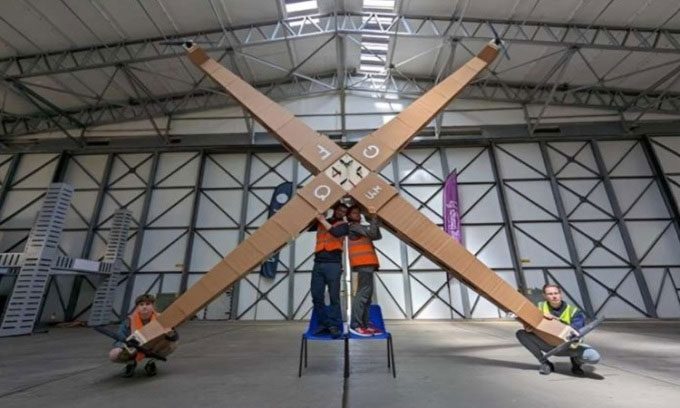The 4-rotor drone developed by the University of Manchester has a wingspan of 6.4 meters, equipped with 4 electric motors and autonomous flight capabilities.

The research team created a drone made from foam. (Photo: University of Manchester).
Engineers at the University of Manchester have designed and flight-tested the world’s largest 4-rotor drone. The drone is made from foamboard material, similar to cardboard, with a wingspan of 6.4m and a weight of 24.5kg, just 0.5kg below the weight limit set by the Civil Aviation Authority (CAA), Phys.org reported on October 23. This advanced drone design, named Giant Foamboard Quadcopter (GFQ), is unlike any existing drone model. Its four rotors are formed from a series of hollow box structures that can be easily disassembled for transportation.
The project initially started as an initiative to inspire students to unleash their creativity in design by utilizing low-cost materials suitable for lightweight, eco-friendly aerospace structures, as opposed to carbon fiber. Unlike carbon fiber, the low-density sheet material is highly recyclable and even biodegradable. The research team hopes the project will encourage the next generation of designers to think about sustainability from an entirely new perspective.
“Foam is an interesting material. If used appropriately, we can create many complex aerospace structures, where each part is designed to be sturdy when needed. Thanks to this design specialty and contextual research, we can confidently assert that this is the largest 4-rotor drone in the world,” said Dan Koning, an engineer at the University of Manchester and the lead designer of the vehicle.
While this drone model was developed purely as a proof-of-concept exercise, future versions of the vehicle could transport large cargo over short distances or be used in aerial pairing experiments. The 4-rotor drone is constructed from 5mm thick foam panels with a foam core and an outer paper shell. The foam panels are laser-cut to the desired size and manually assembled into a 3D structure using only hot glue.
The GFQ operates using 4 electric motors powered by a 50-volt battery pack. It also features a flight control system and has the capability for autonomous flight. The first flight took place on July 5, 2023, inside the main hangar at the Snowdonia Aerospace Centre. The project builds on the previous success of a large fixed-wing foam aircraft developed in 2022. The research team is currently looking to optimize the design of the GFQ.


















































